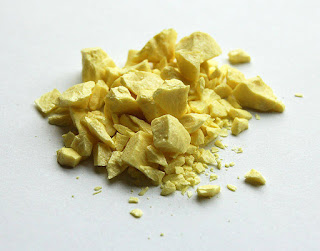Welcome To TIP TOP Chemistry Blog 'Never Ever Give Up Until Success'
Saturday, September 10, 2011
ACIDS
Diprotic acid - two H+ ions per molecule acid. exp : H2SO4
Tuesday, August 9, 2011
ACIDS AND BASES
Tuesday, June 14, 2011
BERITA BAIK UNTUK SEMUA...
Nak belajar sendiri....
Nak cari apa-apa tentang kimia.....
buka alamat ini........ www.gcsescience.com
hendak seribu daya....
tak nak seribu dalih......
TQ
Monday, June 13, 2011
TRANSITION ELEMENTS.............
 Copper
CopperLocation on the Periodic Table
The transition elements are located in groups 3 to 12 of the periodic table.
Properties
Because they possess the properties of metals, the transition elements are also known as the transition metals. The transition elements have low ionization energies. They exhibit a wide range of oxidation states or positively charged forms. The positive oxidation states allow transition elements to form many different ionic and partially ionic compounds. Thus, the complexes form characteristic colored solutions and compounds. Complexation reactions sometimes enhance the relatively low solubility of some compounds.
Summary of Common Properties
- Low ionization energies
- Positive oxidation states
- Very hard
- High melting points
- High boiling points
- High electrical conductivity
- Malleable
- Five d orbitals become more filled, from left to right on periodic table
METALLOIDS........
 Tellurium
TelluriumLocation on the Periodic Table
The metalloids or semimetals are located along the line between the metals and nonmetals in the periodic table. The metalloids are boron, silicon, germanium, arsenic, antimony, and tellurium. Polonium is often considered a metalloid, too.
Properties
The electronegativities and ionization energies of the metalloids are between those of the metals and nonmetals, so the metalloids exhibit characteristics of both classes. Silicon, for example, possesses a metallic luster, yet it is an inefficient conductor and is brittle. The reactivity of the metalloids depends on the element with which they are reacting. For example, boron acts as a nonmetal when reacting with sodium yet as a metal when reacting with fluorine. The boiling points, melting points, and densities of the metalloids vary widely. The intermediate conductivity of metalloids means they tend to make good semiconductors.
Summary of Common Properties
- Electronegativities between those of metals and nonmetals
- Ionization energies between those of metals and nonmetals
- Possess some characteristics of metals/some of nonmetals
- Reactivity depends on properties of other elements in reaction
- Often make good semiconductors
BLUE COLOUR..........
I can mantain my colour or bleach to colourless
depend on type of electrode used.
Monday, April 18, 2011
ELEMENT OF THE DAY..........SULPHUR

Sulfur is an element that many people recognize in its pure form as a yellow solid. The element exists free in nature and forms many important compounds, such as sulfuric acid, hydrogen sulfide and several vital enzymes. Some well-known odors, including skunk, rotten egg, onion and grapefruit, are due to the presence of sulfur compounds. The element is essential for life, yet many sulfur compounds are toxic.
Properties: Sulfur has a melting point of 112.8°C , boiling point of 444.674°C, specific gravity of 2.07 at 20°C, with a valence of 2, 4, or 6. Sulfur is a pale yellow, brittle, odorless solid. It is insoluble in water, but soluble in carbon disulfide. Multiple allotropes of sulfur are known.
Uses: Sulfur is a component of gunpowder. It is used in the vulcanization of rubber. Sulfur has applications as a fungicide, fumigant, and in the making of fertilizers. It is used to make sulfuric acid. Sulfur is used in the making of several types of paper and as a bleaching agent. Elemental sulfur is used as an electrical insulator.
Saturday, March 19, 2011
Tuesday, February 22, 2011
JUST LIKE SOLAR SYSTEM..........
By James Chadwick
SUBATOMIC :
PROTON (+)
NEUTRON (no charge)
Both located in nucleus
ELECTRON (-)
Round nucleus at certain orbit
RELATIVE MASS OF :
PROTON - 1
NEUTRON -1
ELECTRON -1/1840
almost 0
Wednesday, February 9, 2011
FRACTIONAL DISTILLATION


Fractional distillation is the separation of a mixture into its component parts, or fractions, such as in separating chemical compounds by their boiling point by heating them to a temperature at which several fractions of the compound will evaporate.
Tuesday, January 18, 2011
What is Naphthalene?
Wednesday, January 5, 2011
WHAT IS CHEMISTRY?

Chemistry is the science concerned with the composition, structure, and properties of matter, as well as the changes it undergoes during chemical reactions.






